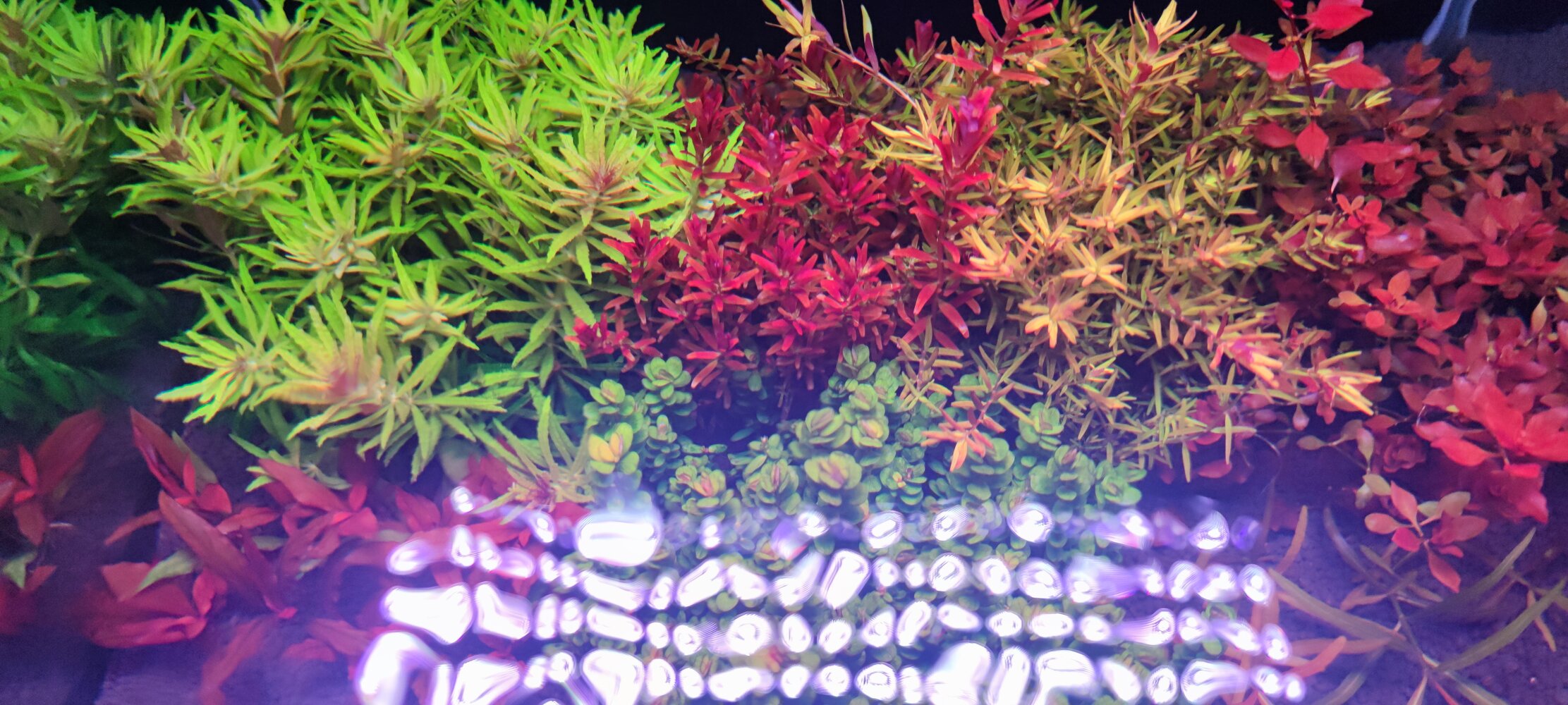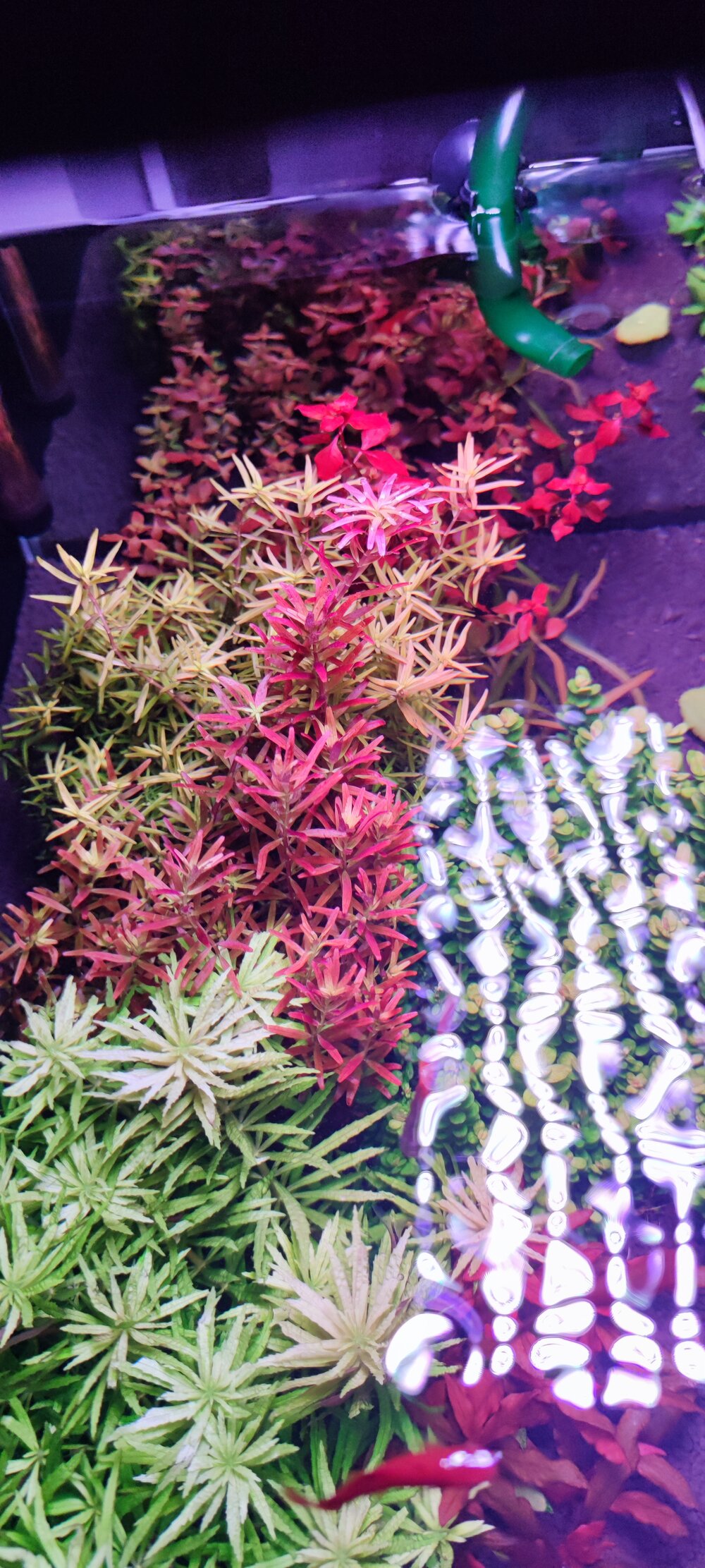-
You are viewing the forum as a Guest, please login (you can use your Facebook, Twitter, Google or Microsoft account to login) or register using this link: Log in or Sign Up
You are using an out of date browser. It may not display this or other websites correctly.
You should upgrade or use an alternative browser.
You should upgrade or use an alternative browser.
red plant color change
- Thread starter hasan66
- Start date
Hi friends, my Rotala blood red plant is red when the lights are first turned on, I look at it in the following hours, there is no trace of the color, what could be the reason?
Are you saying that this happens every day:
(1) lights on - Plant turns red
(2) several hours later - Plant turns colourless
(3) lights off - in the dark, plant turns red again- because the next day, the moment the light is turned on it is red.
I doubt it is possible for Rotala Blood Red to change colour that fast and that much? Please post a photo of the colourless Rotala?
Hi all,
cheers Darrel
my Rotala blood red plant is red when the lights are first turned on, I look at it in the following hours, there is no trace of the color, what could be the reason?
I don't think it is that the red pigment (anthocyanin) is appearing and disappearing. I think colourless means green (no red colour)? and I think that the red colour is <"masked by chlorophyll"> production during "lights on".(1) lights on - Plant turns red
(2) several hours later - Plant turns colourless
(3) lights off - in the dark, plant turns red again-
cheers Darrel
_Maq_
Member
Firstly, I don't think it can go that fast, even repeatedly. Secondly, strong light provokes "economy" in chlorophyll creation, not enhancement.I think that the red colour is <"masked by chlorophyll"> production during "lights on".
Hi all,
We have another (inconclusive) thread where the same process was observed, but not in the same sequence - <"Rotala changes colour daily.....">.
* I'm not a plant physiologist.
cheers Darrel
It does and also anthocyanin production is likely to be enhanced in more intense light, so you would expect the plants would appear more red, rather than less red, but I can't think of another option*.Secondly, strong light provokes "economy" in chlorophyll creation, not enhancement.
We have another (inconclusive) thread where the same process was observed, but not in the same sequence - <"Rotala changes colour daily.....">.
* I'm not a plant physiologist.
cheers Darrel
Last edited:
Herkese selamlar,
Bunun her gün olduğunu mu söylüyorsunuz?
(1) ışıklar yanıyor - Bitki kırmızıya dönüyor
(2) birkaç saat sonra - Bitki renksizleşir
(3) ışıklar kapalı - karanlıkta bitki tekrar kırmızıya dönüyor - çünkü ertesi gün ışık açıldığında bitki kırmızı oluyor.
Rotala Kan Kırmızısı'nın bu kadar hızlı ve bu kadar renk değiştirmesinin mümkün olduğundan şüpheliyim? Lütfen renksiz Rotala'nın bir fotoğrafını yayınlar mısınız?
Öyledir ve ayrıca antosiyanın üretiminin daha yoğun ışıkta oluşması muhtemeldi, bu nedenle başvuru daha az kırmızı yerine daha kırmızı bir görünüm bekliyorsunuz, ancak aklıma başka bir seçenek gelmiyor*.
Aynı süreç gözlemlendiği ancak aynı sırada değildi (sonuçsuz) başka bir konu daha var - <" Rotala her günün rengi değişir..... ">.
* Ben bitki fizyoloğu değilim.
şerefe Darrel
Herkese selam,
Öyledir ve ayrıca antosiyanin üretiminin daha yoğun ışıkta artması muhtemeldir, bu nedenle bitkilerin daha az kırmızı yerine daha kırmızı görünmesini beklersiniz, ancak aklıma başka bir seçenek gelmiyor*.
Aynı sürecin gözlemlendiği ancak aynı sırada olmadığı (sonuçsuz) başka bir konu daha var - <" Rotala her gün renk değiştirir..... ">.
* Ben bitki fizyoloğu değilim.
şerefe Darrel
Attachments
Hi all,

That looks like iron (Fe) deficiency, which would account for the reds shining through more strongly.
The reason that it is likely to be iron (Fe), rather <"than nitrogen (N)"> etc., is just that the <"new leaves are pale">.
cheers Darrel
I can now definitely say it isn't chlorophyll.but I can't think of another option*.
That looks like iron (Fe) deficiency, which would account for the reds shining through more strongly.
The reason that it is likely to be iron (Fe), rather <"than nitrogen (N)"> etc., is just that the <"new leaves are pale">.
cheers Darrel
_Maq_
Member
"New" leaves, well, that's true, but what if we look at "most illuminated" leaves?The reason that it is likely to be iron (Fe), rather <"than nitrogen (N)"> etc., is just that the <"new leaves are pale">.
Somewhere in the cellar of my memory remains a piece of information that strong light can hinder magnesium transport or utilization. If only I recalled the source!
Hi, I dose DTPA 7% eddha 6% 3 times a week on micro days, that is, 0.15 dtpa 0.5eddha 0.6 ppm iron a week, and as an extra I give 0.5ppm iron glucate every day.Hi all,
I can now definitely say it isn't chlorophyll.
View attachment 212939
That looks like iron (Fe) deficiency, which would account for the reds shining through more strongly.
The reason that it is likely to be iron (Fe), rather <"than nitrogen (N)"> etc., is just that the <"new leaves are pale">.
cheers Darrel
I suspect magnesium"New" leaves, well, that's true, but what if we look at "most illuminated" leaves?
Somewhere in the cellar of my memory remains a piece of information that strong light can hinder magnesium transport or utilization. If only I recalled the source!
My friend, I am using Week Aqua Z400. When I lower the power to 59% in the settings, I see brown algae forming."New" leaves, well, that's true, but what if we look at "most illuminated" leaves?
Somewhere in the cellar of my memory remains a piece of information that strong light can hinder magnesium transport or utilization. If only I recalled the source!
So what is your suggestion to me, what should I do?Hi all,
I can now definitely say it isn't chlorophyll.
View attachment 212939
That looks like iron (Fe) deficiency, which would account for the reds shining through more strongly.
The reason that it is likely to be iron (Fe), rather <"than nitrogen (N)"> etc., is just that the <"new leaves are pale">.
cheers Darrel
John q
Member
@hasan66 do your lights ramp up? I can't help think that the colour change, and apparent healthy plants (img 114) suddenly change into FE/MG deficient plants in the space of an hour (img 116) and the return to their full glory overnight.
I suspect some kind of spectrum change as it ramps/warms up in the light is helping trick our eyes into believing they are two starkly different colours.
That's my random thought. 🫣
I suspect some kind of spectrum change as it ramps/warms up in the light is helping trick our eyes into believing they are two starkly different colours.
That's my random thought. 🫣
No, the lights are at a low setting, there is a medium brightness, I don't know the par value, but I'm sure I dosed the iron well, it could just be magnesium because I use RO water, I assume that the brand I use is not for planted aquariums, because it says on it that it is beneficial for fish reproduction and the skeletal system, there is no shop selling a quality mineral salt in our region gh /kh can you help me make minerals?@hasan66 do your lights ramp up? I can't help think that the colour change, and apparent healthy plants (img 114) suddenly change into FE/MG deficient plants in the space of an hour (img 116) and the return to their full glory overnight.
I suspect some kind of spectrum change as it ramps/warms up in the light is helping trick our eyes into believing they are two starkly different colours.
That's my random thought. 🫣
John q
Member
Can you not obtain Magnesium Sulfate (MgSO4) ?can you help me make minerals?
yes I can buy epsom saltCan you not obtain Magnesium Sulfate (MgSO4) ?
John q
Member
Cool.yes I can buy epsom salt
So simply add some MgSo4 to the tank. There's plenty of us here that can do the calcs if need, just tell us the tank size and how much water you charge per week.
Might also be helpful if you let us know what other fertilizer you add to the tank, npk, ca and mg if you know.
Last edited:
Mat H
Member
Interesting to note that Clive did once state "I think Rotala is in a class by itself in terms of the mechanism of it's color changes. Perhaps in this case, staying non-red is it's form of protection from high energy." - green rotal rotundifolia
Aka light, which would fit the on/off light pattern @erwin123 suggested.
Whilst this may have been in the context of longer term changes I can well believe it to be true during daily light cycles for a select few plants with delicate leaves.
Aka light, which would fit the on/off light pattern @erwin123 suggested.
Whilst this may have been in the context of longer term changes I can well believe it to be true during daily light cycles for a select few plants with delicate leaves.
If you cut and paste the green plant (Limnophila sp?) and place the photo side by side, there is a pronounced difference.
If you took these photos a few hours apart (on lights on and a few hours later) It sort of suggests that the camera settings or lighting conditions were different, rather than the plant mkaing this radical change. The photography side of me wonders if the first photo was taken just after the lights turned on, and therefore the intensity was just ramping up, because the more intense saturation could just be due to camera underexposure ( a common trick to get very red plants).
Take the older growth at the bottom - the green is completely different in shade and tone.
The only time I've seen a plant turn white like that after a few hours would be due to a UV-C bulb exposure...




